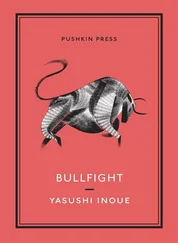WHILE SHINGEN STILL MOURNED Princess Yuu’s death, his army quickly advanced to Ina. In March, the second year of the Kouji, 79Kansuke also took part in the campaign.
At the time of the battle against Kiso, in the mountains, they could still use horses, but on this campaign their horses could hardly be used at all. The troops marched in single file on the steep mountain paths, alongside sheer cliffs overlooking the torrents of the Tenryu River. 80They climbed over several mountains, which had never been crossed before.
One by one, the Takeda armies attacked and captured the small castles that were scattered throughout the Ina valleys. Two weeks into the campaign, they received a report that Uesugi Kenshin Kagetora of Echigo had started his own campaign in Kawanakajima. The Takeda army was stationed in a small village in which several farmhouses were built close together on the corner of a vast, dry riverbed off of the Tenryu River. As soon as they received the information, they immediately held a meeting to discuss how to deal with this new situation.
“I don’t think this is anything serious. Let us ignore them for now and continue capturing all the castles and forts in the Ina district. When Uesugi marches down from the north, then we can withdraw all our troops from Ina and fight him,” said Shingen.
The Takeda’s confidence in his armies was quite evident.
“I agree with you,” said Kansuke. To the other generals, Kansuke’s response to his lord’s words was totally unexpected. As a rule, it was Kansuke’s custom to contradict Shingen’s bold ideas and come out with more cautious strategies.
Yamagata Masakage was the first samurai to oppose the idea.
“For any enemy other than Kenshin Kagetora, I would agree with you. But, I strongly suggest that you avoid using such a strategy with Uesugi Kenshin,” said the young officer, who had a fine record in warfare to support his words. Akiyama Nobutomo also supported the words of the young officer. Shingen seemed hesitant to abandon the subjugation of the Ina district at this point, as he did not want to be intimidated by the news of the appearance of Uesugi Kenshin.
“All right,” Shingen attempted to camouflage his feelings of disappointment by asking Kansuke, “Kansuke, what do you think?”
“I do understand General Obu’s opinion, although I do think the same way as my lord, if everybody agrees. But, if there are some other opinions, we should take them into consideration.”
“Well, then what do we do?”
“Taking General Obu’s words to mind, we should send half of our army to northern Shinano,” said Kansuke. He was very compliant. There was a huge difference in personality between Shingen and Kansuke.
“Who will go?”
“I believe, it is you, My Lord, who should go.”
“No, not me,” said Shingen, “This will be simply for intimidation; therefore there won’t be any fighting there.”
“You are absolutely right. It is not like Uesugi Kenshin to attack you, just because it is the commander-in-chief who is leading the troops.”
“I am not interested in going. I would prefer it if somebody else would go.”
“Yes, but if somebody else goes, it will become a battle.
Then, we will be in trouble. So it must be led by you, My Lord.”
Kansuke believed it. The idea of not sending anybody to northern Shinano was fine. But if they were going to send somebody, it had to be the commander-in-chief, Shingen.
When the meeting was over, Shingen left for Kawanakajima, leaving part of his army in Ina. It was decided that Kansuke would stay there and continue capturing castles.
As Shingen expected, there was no declaration of war at Kawanakajima. Uesugi Kenshin never moved from his camp in Zenkoji Temple, while Shingen settled in his camp on Chausu Mountain. Neither yielded for over a month, and on May the first, Uesugi Kenshin finally broke camp and left for Echigo. Following Kenshin’s lead, Shingen also marshalled his troops and went back to Ina.
While Shingen was in northern Shinano, the Takeda’s armies, under the leadership of Kansuke, conquered the entire district of Ina. All who surrendered were forgiven, and all who did not were put to death.
“There is not a single territory in Ina which does not bow to you as their lord, My Lord.” said Kansuke,
“How about Mizoguchi, Kurokawaguchi, and Odagiri?”
“They were all put to death.”
“How about Miyata, Matsushima, Tonojima?”
“I also put them to death.”
“How about Hanyu, Inabe, and…?”
“They also…”
“Killed?”
Kansuke did not change his expression at all. It gave Shingen an eerie feeling.
“It means you put every one of them to death.”
“Yes, since they all showed indecisive attitudes toward your leadership, I felt it better to cut off the evil at its roots. But the ones who surrendered, I did not harm at all.”
As Kansuke had mentioned, the great numbers who surrendered were several times more than Kansuke’s troops, and they were all gathered on the dry riverbed of the Tenryu River. The other generals were having difficulty understanding how Kansuke, alone, with his small army could conquer so many fortresses in Ina, which had resisted the Takeda for so many years.
That night, the army of the Takeda gave a feast in honor of the victory.
Akiyama Nobutomo was ordered to take charge of the Ina district and protect Takato Castle. Yamagata Masakage became a general of 500 mounted samurai and Kasuga Danjo-no-Chu became the successor of the famous family name, in the Shinano District, Kosaka. He called himself Kosaka Danjo-no-chu and was transferred to northern Shinano as the leader of 450 mounted samurai. The lineup was complete; Akiyama Nobutomo was holding Ina in check, and Kosaka Danjo-no-chu was keeping an eye on Uesugi Kenshin of Echigo.
That evening and until late into the night, Shingen and Kansuke faced each other in the inner guest room of a farmhouse in their main camp.
“Now, what should we do?”
“Let’s attack Joshu.”
“How about Bushu?”
“Fine, we’ll attack Bushu too.”
“Don’t you think somebody else will disagree with us again?”
“I don’t think so.”
Their eyes met. Shingen smiled, but not Kansuke. For a while they looked each other straight in the eyes.
“You are not fair,” said Shingen suddenly.
“What do you mean?”
“At the time of the subjugation of Ina, you drew the better straw.”
“I could not help that.”
“This time, I will go and fight, and you cannot prevent me from doing so.”
“I shall not say a word, but I will go with you too. I beg you not to leave me here as a housekeeper; it is so boring.”
They both started to laugh and just as quickly as the laughter started, it stopped. They both felt a sudden sadness at the absence of Princess Yuu. It was as if a gust of cold wind had blown into the room at just that moment.
From the fall of that year, the banner of Furin Kazan never stayed at Kofuchu for more than half a year. Like the starving tiger seeking food, thus the Takeda army sought war. They repeated the process of war countless times, riding out in all four directions, fighting, winning, and returning, once more, to Kofuchu.
It was in the third year of Koji when Shingen marched his army over Fuefuki Sunset Point and headed to the Joshu district where he crushed the large army of Nagano Shinano-no-kami at the battle of the Kamejiri. Even before this battle was over, Shingen received information about Kenshin appearing at Kawanakajima, and he moved his army to northern Shinano.
As usual, both armies avoided a battle and spent the summer and autumn months standing toe to toe, neither budging and as Kenshin withdrew his army, Shingen also assembled his troops for withdrawal.
Читать дальше












